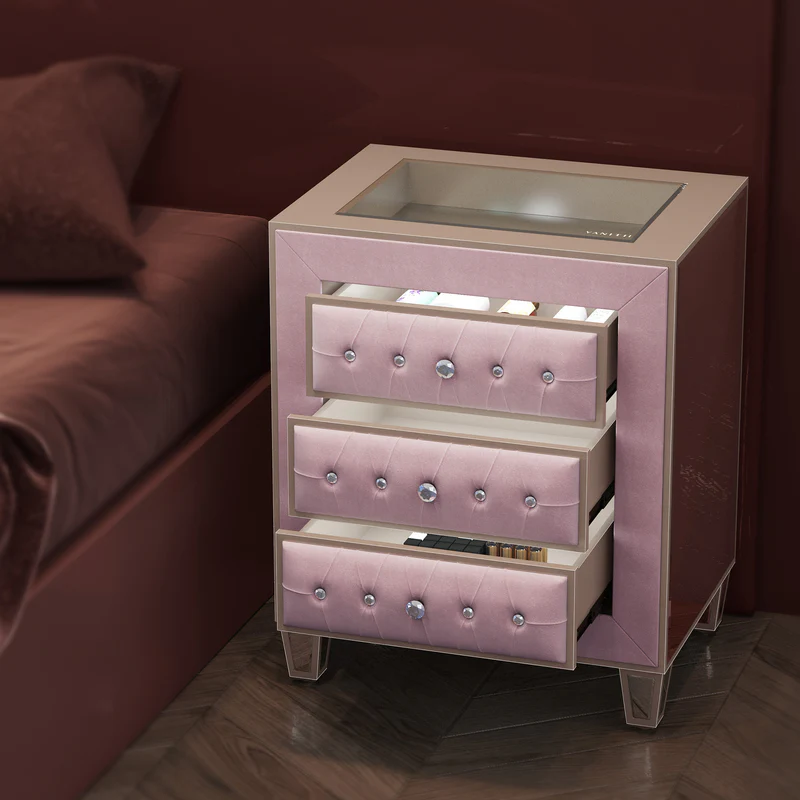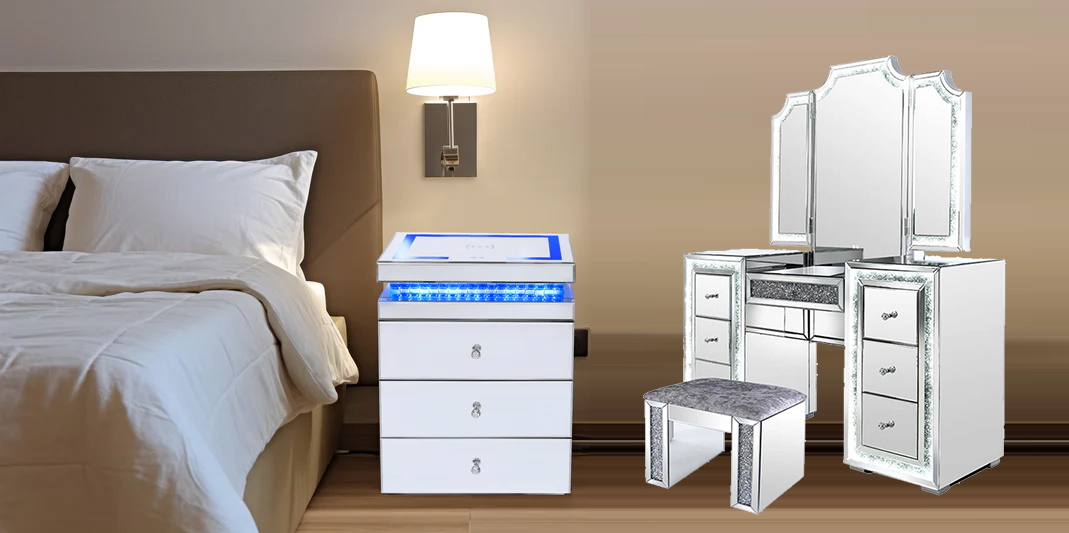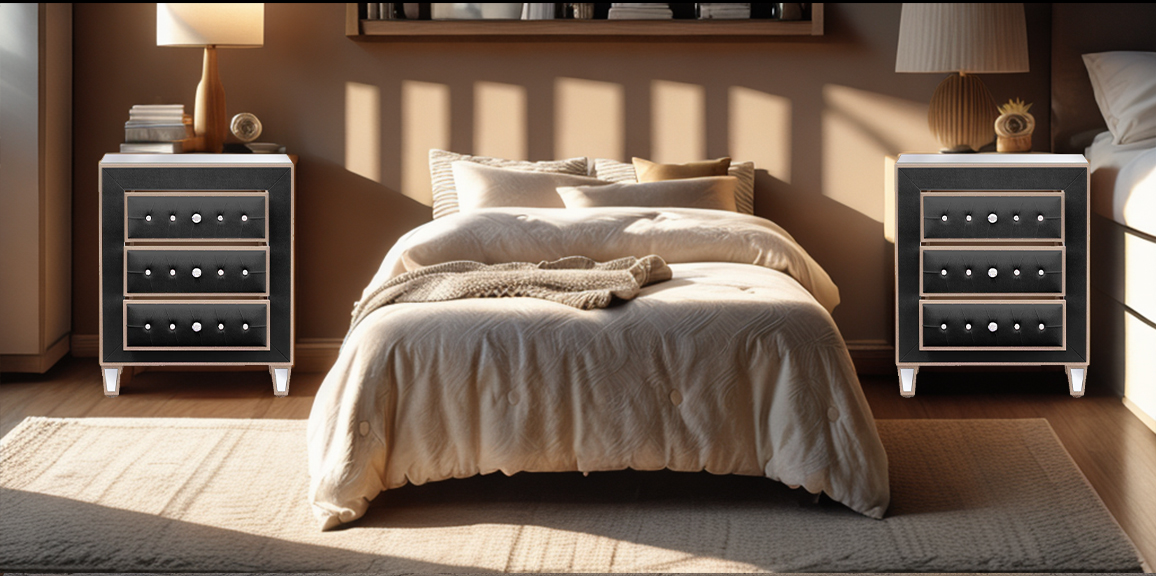The choice between one or two bedside tables depends primarily on your specific needs and circumstances. If you have a smaller bedroom or you sleep alone, one bedside table might be perfect - it saves space and money while keeping essentials within reach. However, if you share your bed with a partner, have a larger bedroom, or prefer a symmetrical look, two bedside tables would be the better choice. They provide equal access to storage for both sides of the bed and create a balanced, traditional appearance. Your decision should ultimately be based on your room size, sleeping arrangements, storage requirements, and personal style preferences, with budget also being a key consideration.
Pros and Cons of Having One Bedside Table
Choosing a single bedside table for your bedroom has its upsides and downsides. This option affects your room's layout, storage, and overall functionality.
Advantages
1. Space-Saving for Smaller Rooms
A single bedside table works well in compact bedrooms. It frees up floor space, making your room feel less crowded. The extra room allows for easier movement or the addition of other furniture pieces.
2. Cost-Effective Option
Opting for one table instead of two can reduce your expenses. This approach is beneficial if you're furnishing your bedroom on a limited budget. It also gives you the flexibility to invest in a higher-quality piece, as you're only purchasing one item.
3. Simple Design and Easy Maintenance
One bedside table creates a clean, uncluttered look in your bedroom. Keeping the area tidy becomes simpler with just one surface to manage. You can quickly organize your essentials and clean the space without much effort.

Disadvantages
1. Limited Storage Space
A single table provides less space for your nighttime necessities. You might struggle to accommodate everything you need, such as books, glasses, a lamp, or a water bottle. This limitation can be frustrating if you prefer having multiple items within arm's reach.
2. Potential Imbalance in Room Appearance
Using only one table can create an asymmetrical look, particularly in larger rooms or with wider beds. This lack of balance might not appeal to those who favor a symmetrical bedroom design.
3. Inconvenient for Shared Beds
For couples or anyone sharing a bed, one table can pose practical challenges. It provides easy access for only one person, while the other might need to reach across or get out of bed to retrieve items. This arrangement can be bothersome, especially during nighttime or early morning routines.
Pros and Cons of Having Two Bedside Tables
Two bedside tables offer a different set of advantages and challenges for your bedroom setup. This arrangement can significantly impact your room's functionality and aesthetics.
Advantages
1. Symmetry and Balance in Room Design
Two matching bedside tables create a harmonious look in your bedroom. This symmetrical arrangement is visually appealing and can make your space feel more organized and put-together. It's particularly effective in larger rooms or with king-size beds, where balance is key to the overall design.
2. Individual Space for Partners
For couples sharing a bed, having two tables provides each person with their own dedicated space. This setup allows both individuals to keep their personal items close at hand without encroaching on their partner's area. It can lead to smoother morning and bedtime routines, as everything is within easy reach for both people.
3. Extra Storage and Surface Area
With two tables, you double your storage and surface space. This additional room is useful for keeping more items nearby, such as books, electronics, medications, or decorative elements. It also provides extra space for practical items like lamps or alarm clocks on both sides of the bed.

Disadvantages
1. Requires More Space
Two bedside tables take up more floor space than a single table. In smaller bedrooms, this can lead to a cramped feeling or restrict movement around the bed. It's important to measure your available space carefully before committing to this option.
2. Higher Cost
Purchasing two tables naturally costs more than buying just one. This increased expense can be a significant factor if you're furnishing your bedroom on a tight budget. Additionally, finding two matching tables that fit your style and space requirements might be more challenging and potentially more costly.
3. Potential for Clutter
With more surface area and storage space, there's a risk of accumulating unnecessary items. This abundance of space might encourage keeping things you don't really need, leading to a cluttered appearance. Maintaining organization on two tables requires more effort than managing a single surface.
Factors to Consider When Choosing the Number of Bedside Tables
1. Bedroom Size
The size of your room plays a big role in deciding how many bedside tables to use. Measure the space on each side of your bed carefully. Large bedrooms usually have enough room for two tables, while smaller ones might only fit one comfortably. Think about how the tables will affect walking space and access to doors, windows, and closets. Make sure you can move around easily with the tables in place.
2. Sleeping Arrangements
Consider who uses the bed. If you sleep alone, one table might be enough for your needs. For couples, two tables often work better, giving each person their own space for personal items. Even if you're single now, think about whether your situation might change in the future. It's often easier to plan for two tables from the start than to add a second one later.
3. Storage Needs
Think about what you like to keep near your bed at night. This might include books, glasses, a water bottle, phone, or alarm clock. Count how many items you regularly use and consider if you need drawers or shelves. One table might be enough if you don't need much storage. If you have lots of things to keep close by, two tables will give you more space.
4. Room Style
Your bedroom's overall look is important when choosing bedside tables. Two matching tables create a balanced, traditional look. One table can give a more modern or minimalist feel. Make sure your choice fits with your other bedroom furniture, like your bed frame and dresser. The tables should match or complement the style and color of your existing pieces.
5. Budget
Money is a practical factor to consider. Buying two tables usually costs more than getting just one. Think about the quality of tables you can afford. Sometimes, it's better to buy one good-quality table than two cheaper ones. Don't forget to include the cost of any extras, like lamps or decorative items you might want to put on the tables.
6. Personal Preference
Your own comfort and taste are very important. Some people like the symmetry of two tables, while others prefer the simplicity of one. Think about how you use your bedside space and what arrangement would make you feel most at home. Choose what feels right for you and your daily habits.

Creative Alternatives and Compromises
If standard bedside tables don't work for you, try these options:
1. Mix and Match Styles
Use two different tables that look good together. You could have one wooden table and one metal table, or tables of different heights. This makes your room more interesting. Just make sure the tables have something in common, like color or shape.
2. Wall-Mounted Shelves
When you don't have much floor space, use wall-mounted shelves or try one long shelf above the headboard for both sides of the bed. This works well in small rooms.
3. Multifunctional Furniture
Choose furniture that does more than one job. A small dresser can be a bedside table and give you extra storage. Some bed frames have built-in nightstands. You can also find bedside tables with phone chargers built in.
4. Repurposed Items
Use things you already have in new ways. A small stool or a stack of old suitcases can work as bedside tables. This adds character to your room and can save money.
5. Asymmetrical Setup
If you can't fit two big tables, use one normal table on one side and something smaller on the other. This could be a slim table, a wall shelf, or even a plant stand.
These ideas can help you find a bedside setup that fits your room, meets your needs, and matches your style.
Choose Your Perfect Bedside Setup!
When deciding on bedside tables, focus on what suits you best. Think about your room size, storage needs, and personal style. For couples, two tables might work better, while one table could be ideal for smaller rooms or single sleepers. If standard options don't fit, try creative ideas like wall shelves or repurposed items. Your budget matters too. The goal is to make your bedroom comfortable and practical. Pick a setup that helps with your nightly routine and makes your room feel just right for you.




Leave a comment
This site is protected by hCaptcha and the hCaptcha Privacy Policy and Terms of Service apply.